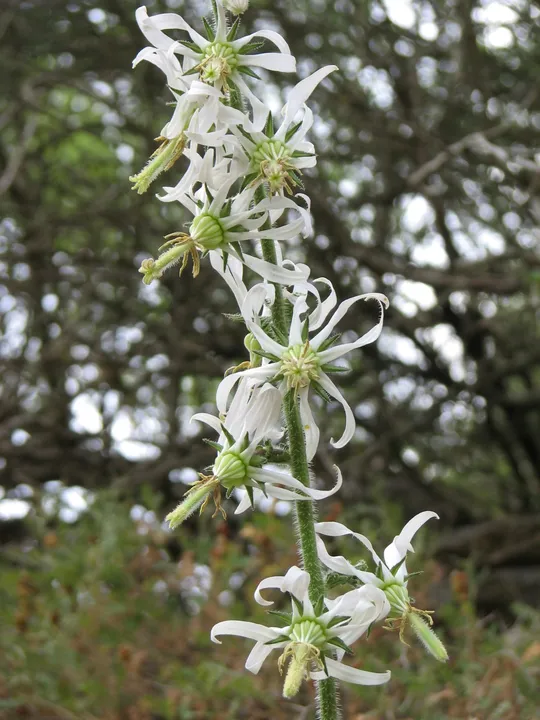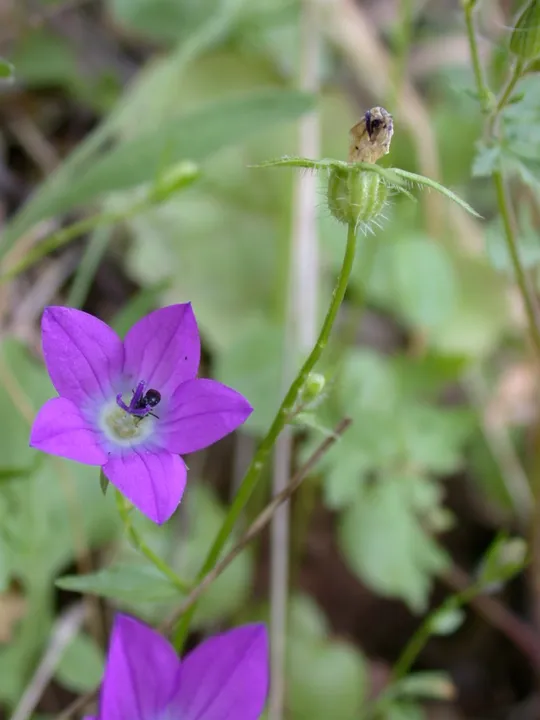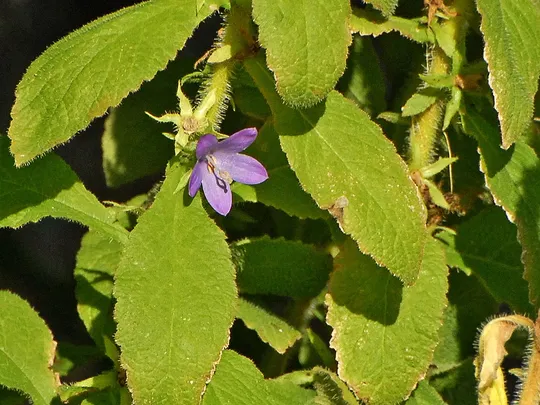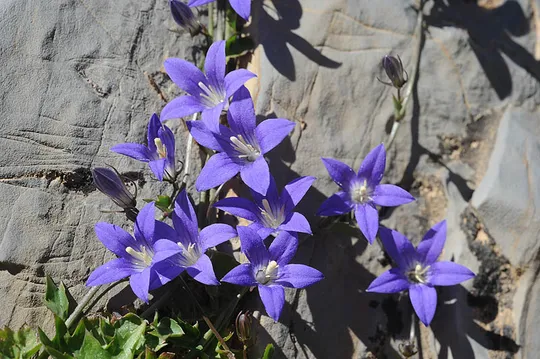Annual Bellflower
Legousia hybrida
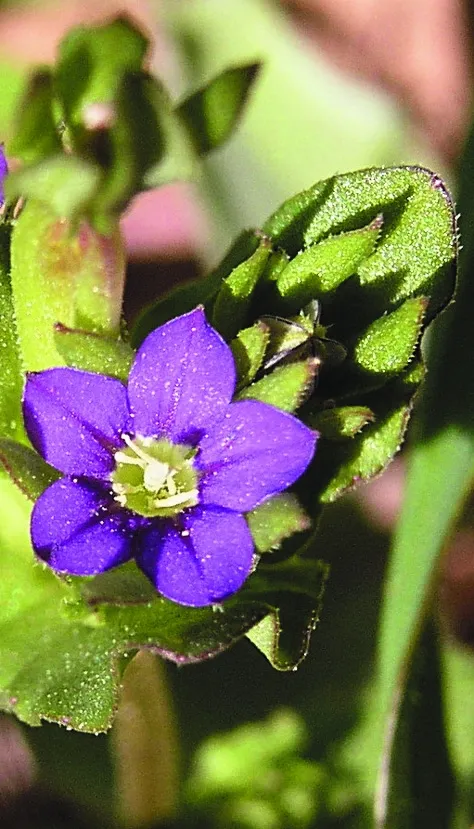
Legousia hybrida is an annual plant, hairless, 5-10 cm tall. Its stem is upright and almost completely unbranched. Leaves are sessile, elongated-oval and wavy. The flowers are sessile, concentrated mainly on the upper section of the stem. The lobes of the fruit calyx are upright and straight, less than one cm long (1/4-1/3 of the length of the ovary). The corolla is a pale blueish-purple and sometimes invisible; it is 3-6 mm long (1/3-1/2 the length of the calyx lobes). In the Mitzpe Yair population on the Ma'on Ridge, there are mixed patches of purple and white flowered plants. L. hybrid blooms in April.
Legousia hybrida grows in three areas in Israel: the Upper Galilee, the Lower Galilee, and the Judean Mountains. In the Upper Galilee, it was collected in 1951 on Mount Meron, and in 1990 Yoav Gertman found it again near Mount Hillel. Since then, all attempts to find it in the area have been unsuccessful. In the Lower Galilee, it was found in an isolated site on the banks of Wadi Evlaim, west of Yodfat (Shir Vered, Ofer Cohen and Aviva Rabinovich), where a population of hundreds of specimens was found on the edges of an olive grove as well as in cultivated fields on terra rossa soil that had been cleared of stones. Efforts to find additional populations in the Galilee have been unsuccessful.
In the Judean Mountains, L. hybrida is known only from Jerusalem: it was collected three times (1930, 1942, 1970) inside the city. One of the sites is in the Matsleva Valley a place famous for rare finds. Since the 1970s, the species has not been found in Jerusalem despite attempts specifically directed to this end.
Lately large populations were found in the area of a Ma'on Ridge in the southern Judean Mountains, particularly at Mitspe Ya'ir at an altitude of 900 meters (Oz Golan 2003). These populations grow along the ridge where traditional agriculture is practiced. Hundreds of plants, in dense populations, which remain stable from year to year, were found in this area.
Field edges in alluvial soil and olive groves on terra rossa soil in mountainous areas.
The genus Legousia is small with approximately five species, common in the Mediterranean and Western Asia. Its general appearance is similar to Campanula. The major difference between the genera is in the ovary, which is inferior in Legousia and superior in Campanula. The capsule is also different, elongated in Legousia and round in Campanula.
The genus is represented by four species in Israel, all annuals that grow in the Mediterranean region. Legousia hybrida differs from the other species in its minute size and its miniscule corolla, which is hidden inside the calyx leaves and is much shorter than them. The small size of the corolla is exceptional compared to the other species that are known for their large and attractive corollas. This suggests that this species underwent an almost obligatory change to self-pollination, so it is not dependent on pollinators, and can reproduce in diverse habitats in difficult or unpredictable conditions. The species most similar to L. hybrida is L. falcata, which differs from L. hybrida in the scythe-like calyx lobes (in the fruit) that appear along the length of the ovary and in the purple corolla. L. falcata also has a short corolla, which is slightly shorter than the calyx, but it is an upright plant that is usually taller than 13 cm. The additional species in the genus are L. speculum-veneris, and L. pentagonia, whose corollas are larger.
* Legousia hybrida is naturally rare, and the number of its populations and the locations where it is found has always been low. At the same time, its only habitat, the edges of olive groves and alluvial mountain soils, is not rare. There is need of more comprehensive information regarding its ecological requirements and the reasons for its rarity. The populations in Jerusalem were probably obliterated due to building and development.
* Its locations are extremely fragmented and more than 30 kilometers apart.
* L. hybrida population size varies between sites, from a few to hundreds of specimens.
* The species is not protected in nature reserves.
The Legousia hybrida populations at Ma'on Ridge should be monitored for a number of years. Preservation of traditional agriculture in terra rossa and alluvial soils in mountainous areas should be considered. Seeds from the Ma'on Ridge populations should be collected and grown in controlled plots in order to study the ecological requirements of L. hybrida and to preserve a source of seeds. Likewise, efforts should be invested in locating it in other sites in its typical habitat in mountainous regions.
The Mediterranean, Western Europe and Atlantic islands: it grows in all the Mediterranean countries from Spain to Cyprus and Lebanon. It extends into the Canary Islands, Central Europe (as a ruderal plant) and the Caucasus.
Legousia hybrida is a small and extremely rare annual plant, found exclusively on the edges of fields and olive groves in the Galilee and Judea, a habitat in which some of its populations are very small and unstable. Recently it was discovered on the Ma'on Ridge, where there are many populations. Because the flower is concealed and difficult to find it in the field, additional populations could potentially be discovered.
Current Occupancy Map
| 1000 squre meter pixel | 5000 squre meter pixel | 10000 squre meter pixel | |
|---|---|---|---|
| number of observations | 0 | 0 | 0 |
| in total pixels | 0 | 0 | 0 |
| Family | Campanulaceae |
| Classification | On the endangered species list |
| Ecosystem | Mediterranean and High Semi-Steppe |
| Chorotype | Mediterranean and Euro – Siberian |
| Conservation Site | Mitspe Ya'ir (Ma’on ridge) and Wadi Evlaim near Kaukab in Lower Galilee |
| Rarity |
1
3
6
|
|---|---|
| Vulnerability |
0
2
4
|
| Attractiveness |
0
0
4
|
| Endemism |
0
0
4
|
| Red number |
1
3.2
10
|
| Peripherality | N |
| IUCN category | DD EW EX LC CR EN VU NT |
| Threat Definition according to the red book | Vulnerable |
 Based on:
Based on:
